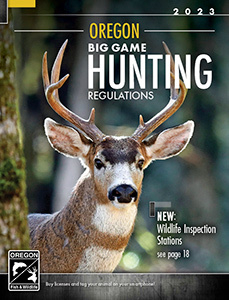Small Game Hunting
Small game species provide a variety of hunting opportunities throughout the state and are an excellent way to introduce new hunters to hunting. Only the appropriate hunting license is necessary to hunt small game (no tags or permits). There are three major categories of small game in Oregon: Western Gray Squirrel, unprotected mammals, and furbearers.
Western Gray Squirrel
The Western Gray Squirrel is a “Game Mammal”. A hunting license is required to hunt Western Gray Squirrels. Western Gray Squirrels can only be hunted during the seasons listed below. Exception: No bag limit or closed season in that part of Unit 30 south of Rogue Rvr and S Fork Rogue Rvr and north of Hwy 140.
North - Central Oregon
Open Season: Sept. 15 - Oct. 31
Bag Limit: 3 squirrels daily.
Possession Limit: 6 in possession.
Open Area: Units 34, 35, 39, 41 and 42.
Remainder of the State
Open Season: Sept. 1 - Nov. 15
Bag Limit: 5 squirrels daily.
Possession Limit: 15 in possession.
Open Area: Units 10-33, 36-38, 40, 43-77.
Unprotected Mammals
Unprotected mammals are not covered under the game mammal, furbearer, or sensitive species rules. For unprotected mammals, there are no closed seasons or bag limits. However, a hunting license is required and all hunting regulations still apply. Commonly hunted unprotected mammals include coyote, cottontail rabbits, black-tailed jackrabbit, opossum, nutria, California ground squirrel, and Belding’s ground squirrels.
- Coyote: Both mouth-blown and electronic calls are legal. Note, if calling coyotes and interested in taking a bobcat, fox, bear, or cougar, if they come to the call, it is necessary to have the appropriate licenses and tags. Bear and cougar require tags, fox and bobcat require a Hunting License for Furbearers; bobcat also require a Bobcat Record Card. (See Furbearers information on this page.)
- Ground Squirrel Hunting:
- In eastern Oregon, the medium sized Belding’s ground squirrels (often referred to as “sage-rats”) are typically hunted from February – July, then they return to their burrows, where they spend the next six to eight months. Most “sage-rat” hunting is in pastures and alfalfa fields so getting permission from the landowner is necessary.
- California ground squirrels (“grey diggers”) can be found in western and central Oregon; they are one of the larger ground squirrels. While they can climb, if startled they head for their burrow, which is another way to distinguish California ground squirrels from tree squirrels species that are protected and usually climb a tree to escape. For more information on Oregon’s squirrels, check https://myodfw.com/wildlife-viewing/species/squirrels-chipmunks-and-marmots.
- Rabbits and Hares are found throughout Oregon.
- Brush rabbits (a variety of cottontail) inhabit the Coast Range, western valleys, and foothills of the Cascades. They can be found feeding and sunning in open areas but will rarely be far from cover. Walking closed logging roads with overgrown vegetation, especially very early in the morning, can produce encounters. While brush rabbits are small, they make for tasty table fare.
- Mountain cottontails are found throughout eastern Oregon, primarily in areas with rock outcrops or rimrock, where they use the small gaps between rocks to escape.
- Black-tailed jackrabbits are primarily hunted in eastern Oregon in the most open, driest “desert” habitats. Black-tailed jackrabbits can also be hunted in the dry habitat around the outside of alfalfa fields where they forage during the night.
- Snowshoe Hares inhabit the mountain ranges of Oregon. Some snowshoe hares, particularly in the Coastal Range, may not turn white in the winter. Few people hunt for snowshoes in Oregon, they tend to live at high elevations where access is difficult in the winter. In western Oregon, like the brush rabbit (a small species of cottontail that is rarely hunted), snowshoes take advantage of dense cover to escape. More information on Oregon’s rabbits and hares can be found online at myodfw.com/wildlife-viewing/species/pikas-rabbits-and-hares.
Furbearers
“Furbearers” include beaver, bobcat, marten, mink, muskrat, otter, raccoon, red fox and gray fox. To hunt furbearers, a Furtaker’s License or a Hunting License for Furbearers is required. For seasons, bag limits and more information please refer to the current “Oregon Furbearer Trapping and Hunting Regulations,” available at any ODFW office, online at myodfw.com/articles/furbearer-trapping-and-hunting, or by contacting Oregon Department of Fish and Wildlife, Trapper Education, 4034 Fairview Industrial Dr. SE, Salem, OR 97302; 503-947-6000.
Feral Pigs
Feral Swine, more commonly known as Wild Pigs, are an invasive, non-native species in Oregon that destroy important habitat. Luckily, there are very few feral swine in the state and they are located almost entirely on private land.
It is legal to hunt feral swine year round on public land. There are no bag limits and hunters must have a valid hunting license. On private land, feral swine are defined as “predatory animals.” Hunting feral swine on private land does not require a hunting license, but you must have landowner permission to act as their agent.
See The Oregon Department of Agriculture Oregon, Administrative Rule 603-010-0055 for the criteria to determine if a pig is considered to be a “feral swine” and legal to harvest.

